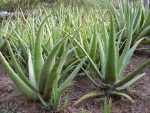 Best known as aloe vera, this evergreen succulent perennial may be native to the Canary Islands, Madeira, and the Cape Verde Islands or the Arabian Peninsula. Plants grow 2-3′ high and form a stemless rosette of glaucous gray green, lanceolate leaves that are 1-2′ long and have white to reddish teeth. The yellow to orange-red flowers are 1-2″ long and appear on slender branched stems 2-3′ long from late spring to early summer. The leaves contain a mucilaginous sap that can be used to treat burns including sunburn and is often included in body lotions and creams for its restorative and medicinal properties. Photo Credit Wikipedia
Best known as aloe vera, this evergreen succulent perennial may be native to the Canary Islands, Madeira, and the Cape Verde Islands or the Arabian Peninsula. Plants grow 2-3′ high and form a stemless rosette of glaucous gray green, lanceolate leaves that are 1-2′ long and have white to reddish teeth. The yellow to orange-red flowers are 1-2″ long and appear on slender branched stems 2-3′ long from late spring to early summer. The leaves contain a mucilaginous sap that can be used to treat burns including sunburn and is often included in body lotions and creams for its restorative and medicinal properties. Photo Credit Wikipedia
Aloe had been used in embalming fluid since ancient Egyptian times and was used in Jewish burial customs at the time of Jesus’ death. Traditionally, Jewish burial customs called for wrapping the body of the deceased in linens strips and myrrh mixed with aloe to cover up the smell of the decaying body. Since aloe has no scent it probably served to fix the fragrance of the myrrh.
Numbers 24.6 (NIV) The sorcerer Balaam describes the camp of the Israelites.
“Like valleys they spread out, like gardens beside a river, like aloes planted by the Lord, like cedars beside the waters.
Psalms 45.8 (NIV) The Messiah is prophisized.
Song of Songs 4.14 (NIV) The bridegroom describes the garden of his beloved.
“ nard and saffron, calamus and cinnamon, with every kind of incense tree, with myrrh and aloes and all the finest spices.”
John 19.39 (NIV) The followers of Jesus prepared His body for burial. Scholars consider seventy-five pounds a more than adequate amount.
“ He [Joseph of Arimathea] was accompanied by Nicodemus, the man who earlier had visited Jesus at night. Nicodemus brought a mixture of myrrh and aloes, about seventy-five pounds. “
Aloe likes full sun to partial shade and average, medium moist, very well-drained soil in USDA Hardiness zones 9-11. Plants are salt and drought tolerant and are useful in borders, succulent gardens, rock gardens, coastal gardens, herb gardens and containers. Propagation is seed, division of offsets, and leaf cuttings. Plants are susceptible to mealy bugs, scale, aphids, and spider mites.
The genus name, Aloe, is derived from the Arabic word alloeh meaning bitter and shiny substance and refers to the latex in the leaves .The specific epithet, vera, is the Latin word meaning true, because it is the standard source for aloe vera, the pharmaceutical substance. The specific epithet, barbadensis, honors Barbados an island in the West Indies.